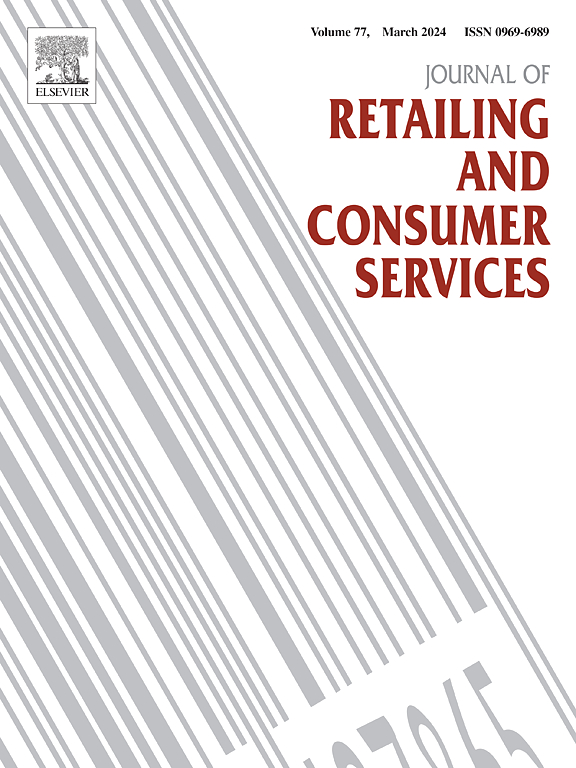From awareness to preference: The dual role of brand and eco-friendliness in shaping green choices
IF 13.1
1区 管理学
Q1 BUSINESS
Journal of Retailing and Consumer Services
Pub Date : 2025-04-05
DOI:10.1016/j.jretconser.2025.104302
引用次数: 0
Abstract
Given the growing popularity of online shopping, promoting environmental awareness and encouraging eco-friendly choices on these platforms are essential for advancing sustainability. This study explores the specific influence of presenting environmental educational video messages right before product selection, focusing on how they enhance visual attention to eco-friendly information and influence price sensitivity, brand impact, and preferences for green products among Generation Z consumers. The research is grounded in a theoretical framework integrating the Elaboration Likelihood Model (ELM), Priming Effect, and Theory of Planned Behavior (TPB). It comprises two studies that combine eye-tracking technology with data collected by questionnaire. To analyze eye-tracking data, this study employs a novel analytical method by integrating Dynamic Grey Relational Analysis (DGRA) with T-tests, providing an advanced approach to evaluate behavioral patterns, ranking variable importance, and addressing non-linearity in consumer attention metrics beyond traditional significance thresholds. Based on the priming effect, the findings indicate that the timing of these messages significantly enhances attention to eco-friendly attributes, reduces price sensitivity, and guides decision-making toward greener choices by emphasizing the importance of sustainability. Additionally, the study highlights the dual role of brand familiarity, showing that under heightened environmental awareness, it strengthens preferences for eco-friendly products while diminishing its influence on non-eco-friendly ones. These insights provide practical implications for marketers and policymakers, emphasizing the strategic use of environmental video messages in digital retail to drive sustainable consumption and reinforcing the importance for brands to align with environmental values to sustain consumer engagement and remain competitive in increasingly sustainability-driven markets.
从意识到偏好:品牌和生态友好在塑造绿色选择中的双重作用
鉴于网上购物越来越受欢迎,在这些平台上提高环保意识和鼓励环保选择对于促进可持续发展至关重要。本研究探讨了在产品选择之前呈现环境教育视频信息的具体影响,重点关注它们如何增强对环保信息的视觉关注,并影响Z世代消费者对绿色产品的价格敏感性、品牌影响力和偏好。本研究基于精化似然模型(ELM)、启动效应(Priming Effect)和计划行为理论(TPB)相结合的理论框架。它包括两项研究,将眼球追踪技术与问卷调查收集的数据相结合。为了分析眼动追踪数据,本研究采用了一种新的分析方法,将动态灰色关联分析(DGRA)与t检验相结合,提供了一种先进的方法来评估行为模式,对变量重要性进行排序,并解决消费者注意力指标中超越传统显著性阈值的非线性问题。基于启动效应,研究结果表明,这些信息的时机显著增强了对生态友好属性的关注,降低了价格敏感性,并通过强调可持续性的重要性来引导决策朝着更环保的选择。此外,该研究强调了品牌熟悉度的双重作用,表明在环境意识增强的情况下,它会加强对环保产品的偏好,同时减少对非环保产品的影响。这些见解为营销人员和政策制定者提供了实际意义,强调了在数字零售中战略性地使用环境视频信息来推动可持续消费,并强调了品牌与环境价值观保持一致的重要性,以维持消费者的参与度,并在日益可持续发展的市场中保持竞争力。
本文章由计算机程序翻译,如有差异,请以英文原文为准。
求助全文
约1分钟内获得全文
求助全文
来源期刊
CiteScore
20.40
自引率
14.40%
发文量
340
审稿时长
20 days
期刊介绍:
The Journal of Retailing and Consumer Services is a prominent publication that serves as a platform for international and interdisciplinary research and discussions in the constantly evolving fields of retailing and services studies. With a specific emphasis on consumer behavior and policy and managerial decisions, the journal aims to foster contributions from academics encompassing diverse disciplines. The primary areas covered by the journal are:
Retailing and the sale of goods
The provision of consumer services, including transportation, tourism, and leisure.

 求助内容:
求助内容: 应助结果提醒方式:
应助结果提醒方式:


